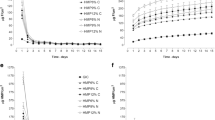Abstract
To compare the effect of ultrasonic setting with self curing on fluoride release from conventional and experimental dental glass ionomer cements. To compare hand mixed and capsule mixing and the effect of replacing some of the reactive glass with zirconia. In a novel material which advocated using radiant heat to cure it, to compare the effect of this with ultrasound. To evaluate the effect of ultrasound on a glass ionomer with fluoride in the water but not in the glass. 10 samples of each cement were ultrasonically set for 55 s; 10 controls self cured for 6 min. Each was placed in 10 ml of deionised water which was changed at 1, 3, 7, 14, 21, 28 days. The solution fluoride content was measured using a selective ion electrode. All ultrasound samples released more fluoride than the controls. Release patterns were similar; after a few days, cumulative fluoride was linear with respect to t1/2. Slope and intercept of linear regression plots increased with ultrasound. With radiant heat the cement released less fluoride than controls. The effect of ultrasound on cement with F in water increased only slope not intercept. Zirconia addition enhances fluoride release although the cement fluorine content is reduced. Comparison of capsule and hand mixing showed no consistent effect on fluoride release. Ultrasound enhances fluoride release from GICs. As heat has an opposite effect the heat from ultrasound is not its only action. The lesser effect on cement with fluoride only in the water indicates that of ultrasound enhances fluoride release from glass.





Similar content being viewed by others
References
Wilson AD. Developments in glass ionomer cements. Int J Prosthodont. 1989;5:438–46.
Davidson CL, Mjőr IA. Advances in glass ionomer cements. Chicago: Quintessence Pub Co; 1999.
Towler MR, Bushby AJ, Billington RW, Hill RG. A preliminary comparison of the mechanical properties of chemically cured and ultrasonically cured glass ionomer cements, using nano-indentation techniques. Biomaterials. 2001;11:1401–6.
Kleverlaan CJ, van Duinen, Feilzer AJ. Mechanical properties of glass ionomer cements affected by curing methods. Dent Mater. 2004;1:45–50.
Algera TJ, Kleverlaan CJ, Prahal-Andersen B, Feilzer AJ. The influence of accelerating the setting rate by ultrasound of heat on the bond strength of glass ionomers used as orthodontic bracket cements. Eur J Orthodont. 2005;26:1–5.
Brune D. Heat treatment of glass ionomer, silicate zinc phosphate and zinc polycarboxylate cements. Scand J Dent Res. 1982;90:409–12.
Rushe N, Towler MR. The influence of ultrasonic setting on fluoride release from glass polyalkenoate cements. J Mater Sci. 2006;41:5775–7.
Talal A, Tanner KE, Billington RW, Pearson GJ. Effect of ultrasound on the setting characteristics of glass ionomer cements studied by Fourier Transform Infra Red Spectroscopy. J Mater Sci: Mater Med. 2009;20:405–11.
Harle J, Parsons NS, Mayia F, Pearson GJ. The effect of ultrasound fields on the curing of glass ionomer cements. Barcelona: ESB; 2002.
Towler MR, Crowley CM, Hill RG. Investigation into the ultrasonic setting of glass ionomer cements Part I postulated modalities. J Mater Sci Lett. 2003;22:539.
Williams JA, Briggs E, Billington RW, Pearson GJ. The effect of adding fluoride compounds to a fluoride free glass ionomer cement on subsequent fluoride and sodium release. Biomaterials. 2003;24:1301–8.
Williams JA, Billington RW, Pearson GJ. The glass ionomer cement: the source of soluble fluoride. Biomaterials. 2002;23:2191–200.
Luo J, Billington RW, Pearson GJ. Kinetics of fluoride release from the glass components of glass ionomers. J Dent. 2009;37:445–501.
Yan ZQ, Sidhu SK, Nomoto R, Mccabe JF. Effects of porosity on the fluoride release and recharging of glass ionomers. BSDR. 2005 (abstract no:0039). Available at: http://iadr.confex.com/iadr/bsdr05/techprogram/abstract_66046.htm.
Verbeeck RM, De Moor RJ, San Even DF, Martens LC. The short term fluoride release of hand mixed vs. capsulated systems of restorative glass ionomer cements. J Dent. 1993;3:577–81.
Jones CS, Pearson GJ, Billington RW. Effects of viscosity in capsulated glass-ionomer cements. J Dent Res. 1997;76(5):432.
Woolford MJ, Grieve AR. Release of fluoride from glass polyalkenoate ionomer cement subjected to radiant heat. J Dent. 1995;4:227–33.
El Mallak BF, Sarkar NK. Fluoride release from glass ionomer cements in de-ionized water and artificial saliva. Dent Mater. 1990;6:118–22.
Meryon SD, Smith AJ. A comparison of the fluoride release from three glass ionomer cements and a polycarboxylate cement. Int Endod J. 1984;17:16–24.
Hill RG, De Barra E, Griffin S, Henn G, et al. Fluoride release from glass polyalykenoate (ionomer) cements. Key Eng Mater. 1995;99–100:315–22.
Author information
Authors and Affiliations
Corresponding author
Rights and permissions
About this article
Cite this article
Thanjal, N.K., Billington, R.W., Shahid, S. et al. Kinetics of fluoride ion release from dental restorative glass ionomer cements: the influence of ultrasound, radiant heat and glass composition. J Mater Sci: Mater Med 21, 589–595 (2010). https://doi.org/10.1007/s10856-009-3901-3
Received:
Accepted:
Published:
Issue Date:
DOI: https://doi.org/10.1007/s10856-009-3901-3




